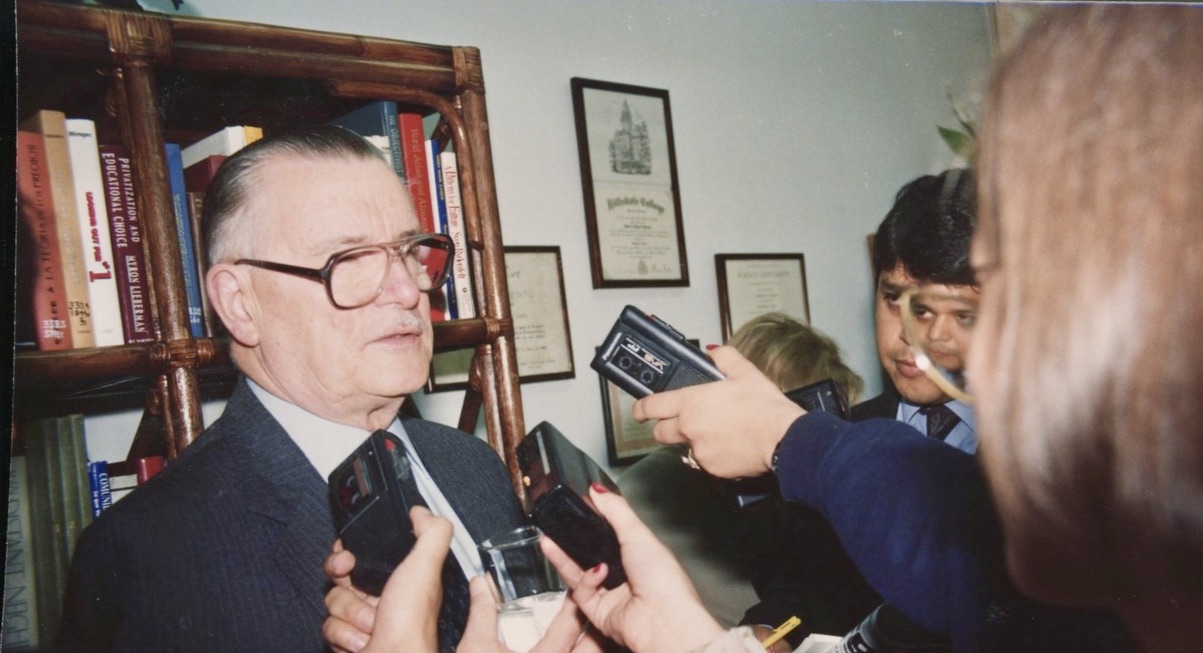Hello all and welcome to Processing from the Outside In: a new blog series where I’ll be sharing with you updates from our National Endowment for the Humanities grant to process the papers of James M. Buchanan. I’m Rebecca Thayer, the project archivist for the grant.
James M. Buchanan (1919-2013) was a Nobel Prize-winning economist and one of the founders of the field of public choice. His 60+ year career spanned institutions, notably the University of Virginia, Virginia Tech (then known as Virginia Polytechnic Institute or VPI) and finally George Mason University. Buchanan was an incredibly prolific academic; his collected works run to 20 volumes. Lots of work means he created lots of papers!
How much, you ask? We usually measure our collections in linear feet (as opposed to cubic feet). The Buchanan papers contain 282 linear feet of materials. If we started at the one yard line of a football field and laid all the boxes in the collection end to end, it would reach to the 5 yard line on the other end!
So how do we make all those papers accessible for researchers? When preparing to process a collection, it’s important to understand the archival principle of original order. Original order is “the organization and sequence of records established by the creator of the records.” Original order is useful because it can help us understand how a creator did their work or how an office functioned. For example, if a creator organized all their letters by topic, we can learn that topics were more important to them than the people they were writing, and we can learn exactly what topics were important to them. If we took out all the papers and rearranged them by correspondent, we would lose that information.
But let’s be honest; I know that the papers that I create in my personal and professional life are not always efficiently organized. Certainly you’ve known someone who could find exactly the piece of paper they wanted out of a massive stack, but anyone else trying to use their files would be lost. In cases like that, archivists have to carefully decide whether keeping the original order will help or hinder a researcher’s work. Another consideration is the time and effort that it would take to rearrange the materials into a more user-friendly order.
Trying to figure out the original order of Buchanan’s papers has been a challenge due to their complicated history. Currently, the collection is all boxed up and properly stored at the Special Collections Research Center (SCRC) in Fenwick Library. But how did it end up there? How did the materials end up in their current order? Is the current order the original order?

An unarranged box of Buchanan’s writings.
Well, I know that the collection was boxed up in Buchanan House and partially arranged by then-economics PhD student Solomon Stein and current member of the SCRC staff Liz Beckman. (For more information, see Liz’s recent blog post) Liz and Solomon have been very helpful in explaining how the papers were originally stored at Buchanan House, which the former home of the Center for Study of Public Choice. Some of the papers were kept and filed on the main floor of the house by librarian JoAnn Burgess, some by Buchanan in his office, and some by administrator Betty Tillman in her office.
Then we have papers that were created at institutions other than Mason that followed Buchanan in his academic travels. Luckily for us, Tillman assisted Buchanan in keeping his papers from 1961 until her retirement in 2007, so it seems like few papers were lost in these transitions. But as anyone who’s moved house would know, space constraints and new projects create new filing needs, requiring new filing systems which might not match old filing systems.
So while this original order can tell us something about the functioning of Buchanan’s office, is it useful for researchers trying to access the collection? We also have to consider time required to do any rearrangement. We’ve got two years (whoops, 21 months!) to finish and we don’t want to get bogged down shifting around thousands of individual pieces of paper.
Right now, I’m surveying about 30% of the boxes in the collection. Not only will that give me a sense of the arrangement, but I can also see what types of materials are in the collection, if the folder titles are accurate to the contents of the folders, and what groupings (or series) might be best for the collection. I also have to check the collection for personally identifiable information (PII) like Social Security numbers of living people that might need to be redacted or restricted.
I’m taking detailed notes on the materials as I go through them to help guide me in making these decisions about arrangement. That will be the next step once the survey is finished. To come up with a plan for arrangement, I’ll rely on those notes while taking into consideration time requirements, researcher needs, and archival standards.

A box of materials organized by Solomon Stein and Liz Beckman
The end goal of our project is to have a full finding aid with description to the folder level posted online, allowing researchers to easily locate the materials they want to see. And I can’t wait to see the knowledge you’ll create with it!
Follow SCRC on Social Media and look out for future posts on our Facebook, Instagram, and Twitter accounts. To search the collections held at Special Collections Research Center, go to our website and browse the finding aids by subject or title. You may also e-mail us at speccoll@gmu.edu or call 703-993-2220 if you would like to schedule an appointment, request materials, or if you have questions.


